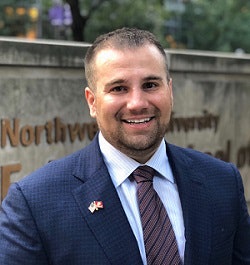Stephen Graves was in his first year at Northwestern University’s Feinberg School of Medicine in 2014 when he discovered that the Post-9/11 GI Bill would cover more of his tuition were he enrolled in law school or MBA program.
 Stephen Graves
Stephen GravesIt was one of those head-scratching “why?” moments that can inspire research, and that’s what Graves did. Now a fourth-year student in the dual MD-MBA program, the 10-year Marine Corps veteran and his team at Northwestern Medicine have released findings of a study investigating veterans’ tuition benefits for graduate programs.
The study, published Tuesday in the Journal of the American Medical Association, analyzed national tuition and financial aid data from medical, law and MBA programs at more than 100 schools.
“Scholarship Support for Veterans Enrolling in MD, JD, and MBA Programs” reported that much less of the cost was being covered for medical school than for juris doctor or master of business administration programs.
Tuition benefits through the U.S. Department of Veterans Affairs program covered only about 45 percent of the tuition for medical school, compared to 85 percent for law and 100 percent for MBA programs, the study found. In real dollars, that added up to a shortfall of about $110,000 – roughly $27,500 each year – for veterans in MD programs after their GI Bill benefits were applied.
The GI Bill, the main source of federal tuition aid for veterans, is a scholarship program available to all honorably discharged veterans that can be used for most undergraduate and graduate education.
Medical school tuition typically is more expensive than tuition for law and business schools. However, Graves noted, medical schools studied also gave less direct support – approximately $22,000 a year compared to about $26,000 for business school and $33,000 for law school.
Further, the study found that school participation in the Yellow Ribbon program, a supplemental opt-in benefit for veterans that matches dollar for dollar a school’s aid contribution, is lower among medical students than among law and business students. While the GI Bill is mandatory, the Yellow Ribbon program for graduate and undergraduate students is voluntary, “so it’s not as consistent and contributes to the discrepancies in aid we found,” Graves said. “All professional programs should re-examine their participation levels and determine if they are adequate.”
Another wrinkle: There are more than a half-dozen eligibility levels in the GI Bill, and only students who qualify at the 100-percent coverage level qualify to participate in the Yellow Ribbon program, said Walter Ochinko, research director at Veteran Education Success.
Additionally, schools individually decide how many vet students their Yellow Ribbon program will serve and how much need they will cover, explained Ochinko. For example, if a medical student needs $30,000 to cover tuition after GI Bill benefits are applied, a school can decide to give $15,000, triggering a Yellow Ribbon match of $15,000, or give less and get the matching amount through Yellow Ribbon – leaving the student with some out-of-pocket cost.
Another factor that probably contributes to the disparity in degree-program tuition benefits is the dearth of veterans in medical school compared to vets in JD and MBA programs, Graves said. “Other graduate programs are more experienced with providing scholarship support to veterans.”
The gap can probably be closed if medical schools become more familiar with tuition aid programs for veterans, Graves suggested. Medical school programs also should stop “benchmarking their support levels to other MD programs” and look at support levels of JD and MBA programs, he added.
An immediate solution is shifting school-granted scholarships for veterans to the Yellow Ribbon program, said Graves.
And given that there is inadequate information about how many veterans are enrolled in or have graduated from medical school, he added, a relevant research question is how aid affects if and where veterans attend medical school.
The bottom line is that some veterans who deployed to combat zones or served on active duty since 9/11 “will incur significant debt despite receiving the GI Bill,” said Graves, who remains a captain in the Marine Corps Reserve. “Medical schools could be using their scholarship dollars much more effectively.”
The research was supported by a grant from the National Cancer Institute of the National Institutes of Health. The study’s other authors are Dr. Brandon-Luke Seagle, a fellow in gynecologic oncology; Dr. Masha Kocherginsky, associate professor of preventive medicine; Dr. Shohreh Shahabi, chief of gynecologic oncology and the John and Ruth Brewer Professor of Gynecology and Cancer Research; and Shahabi lab members Junhua Yang, a statistical analyst, and Anne Grace, a senior clinical research associate.
LaMont Jones can be reached at [email protected]. You can follow him on Twitter @DrLaMontJones





















